
Río Grande, Puerto Rico
El Yunque City
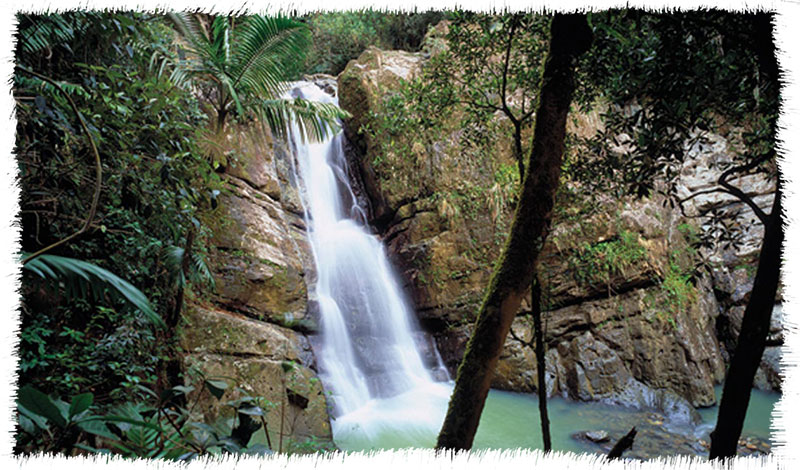
Río Grande (REE-o GRAHN-de) is known as the “City of El Yunque”. The mountainous zone is part of the Caribbean National Forest, which is part of the Luquillo mountain range. The majority of this forest is located within the municipality of Río Grande. The municipality’s patron saint is the Virgen de Nuestra Señora del Carmen.
Río Grande is bordered on the north by the Atlantic Ocean, on the east by the municipalities of Luquillo and Ceiba, on the west by Loíza, and on the south by Naguabo and Las Piedras.
Geographically, it is part of the region called the northern coastal plains. It has alluvial soils, interrupted by some rocky promontories and sand dunes in the coastal area.
The municipality’s economy includes various factories, hotels and golf courses. Agriculture includes commercial flower growing (especially lilies), as well as plantains, yautia, tomatoes, cucumbers and other crops.
Foundation:
Río Grande was founded by don Desiderio Escobar y Quilimaco Escobar, who were empowered by most of the neighbors of this region so that in their names they would ask authorization to populate. The governor Miguel López de Baños acceded and it was founded July 26, 1840.
At the time the municipality was made up of the following wards: Ciénaga Alta, Ciénaga Baja, Jiménez, Guzmán Abajo, Guzmán Arriba, Herrera, Río Grande Pueblo and Zarzal. The name derives from the Grande river, affluent of the Espíritu Santo that flows near the population.
During the years of the conquest and the first years of the colonization, it was within reach of the Caribe and Taíno Indians from the Lesser Antilles, thus the development of the area, like the one of all those of the coastal plain of the northeast, was delayed by their attacks, in which many settlers and animal stock died. Once the Indians of Vieques, Santa Cruz and other islands disappeared, the region’s development continued with the first cattle ranches, sugar cane and fruit farms.
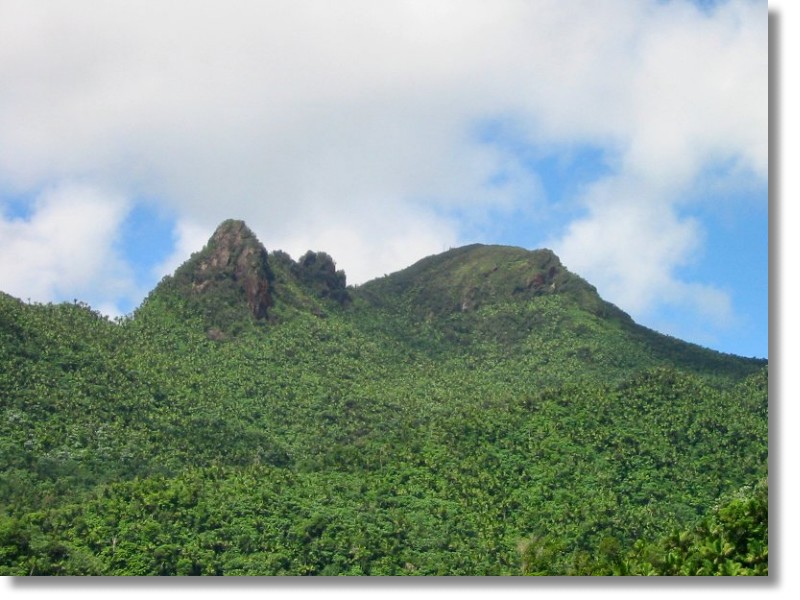
In 1897 the Mameyes II ward of the municipality of Luquillo was annexed to Río Grande. This municipality (Luquillo) was dissolved in 1899 and its wards were distributed between Fajardo and Río Grande. The Mata de Plátano, Mameyes I, Hato Viejo and parts of Sabana wards were also added to Río Grande.
Towards 1910 the Hato Viejo ward disappeared. In 1914, the Legislative Assembly of Puerto Rico, restituted the municipality of Luquillo and all the wards that integrated it before it was dissolved were given back, except for Mameyes II. In its early years the municipal economy was based on the cattle ranching and sugar cane.
Today, the municipality’s economy is mainly based on manufacturing and tourism. In recent years, business, banking and construction have experienced growth.
Location:
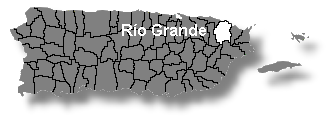 Río Grande is located in what is known as the Northern Coastal Valley. It is bordered north by the Atlantic Ocean and Loíza, to the south by Las Piedras, Naguabo and Ceiba, to the west Canóvanas and Loíza and east with Luquillo and Fajardo.
Río Grande is located in what is known as the Northern Coastal Valley. It is bordered north by the Atlantic Ocean and Loíza, to the south by Las Piedras, Naguabo and Ceiba, to the west Canóvanas and Loíza and east with Luquillo and Fajardo.
Area:
158.6 sq km / 61.0 sq mi
Population:
52,362 (census 2000)
Population Density:
330.1 per sq km / 858.3 per sq mi
People are known as:
Riograndeños
Río Grande is also known as:
El Pueblo de los Bellos Atardeceres
Ciudad del Yunque (Yunque City or Anvil City)
Wards: Río Grande, Puerto Rico

| Census 2000: Population by Wards – Río Grande |
Habitants |
| Ciénaga Alta | 4,606 |
| Ciénaga Baja | 18,220 |
| Guzmán Abajo | 6,614 |
| Guzmán Arriba | 928 |
| Herreras | 839 |
| Jiménez | 2,903 |
| Mameyes II | 2,919 |
| Río Grande (town) | 1,948 |
| Zarzal | 13,385 |
| Total | 52,362 |
Source: Censo 2000
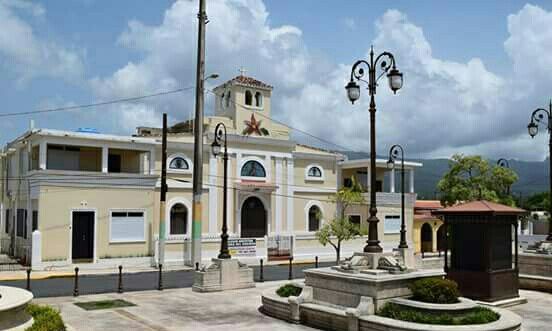
Patron:
Nuestra Señora del Carmen
Parroquia Nuestra Señora del Carmen
Calle Carmen # 9
Río Grande, P.R. 00745
(787) 887-2365
Topography:
It belongs to the region of the Northern Coastal Plains. To the south and the southeast are the highest elevations of the Luquillo Sierra; El Toro and El Yunque.
Hydrography:
It is bathed by the Herrera, Espíritu Santo, Mameyes, Sonador, Grande, La Mina rivers and the Juan Diego, La Máquina, Lingueta, La Toma, Tabonuco and Anón gorges. The terrain close to the coast is level and marshy.
Economy:
Agriculture (sugar cane, fruits, ornamentales plants, vegetables and cattle) and manufacture of textiles.
Average Salary:
$306.99 weekly (1998)
Flag:
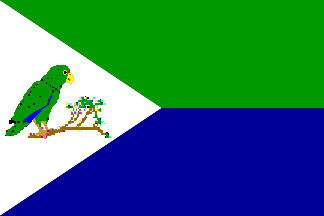 The Río Grande flag consists of two horizontal stripes of equal size united by a white triangle placed on the side of the mast. The superior stripe is green and represents the mountains of that zone. The blue stripe represents the Espíritu Santo river and refers to the name of the town. On the white triangle a Puerto Rican parrot since it is within the Río Grande territory, and specifically in the Luquillo Sierra where some of these endemic species in danger of extinction survive.
The Río Grande flag consists of two horizontal stripes of equal size united by a white triangle placed on the side of the mast. The superior stripe is green and represents the mountains of that zone. The blue stripe represents the Espíritu Santo river and refers to the name of the town. On the white triangle a Puerto Rican parrot since it is within the Río Grande territory, and specifically in the Luquillo Sierra where some of these endemic species in danger of extinction survive.
Coat Of Arms:
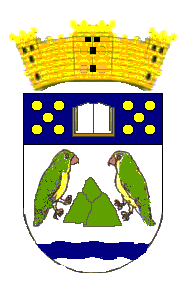 In a silver field, two Puerto Rican parrots(Amazon vitatta vitatta), accompanied by a waving blue stripe, a green mountain with three peaks. The top portion of the shield is blue, with an opened silver book, accompanied on each side by five gold coins. Topped by a three tower gold crown outlined in black with green openings.
In a silver field, two Puerto Rican parrots(Amazon vitatta vitatta), accompanied by a waving blue stripe, a green mountain with three peaks. The top portion of the shield is blue, with an opened silver book, accompanied on each side by five gold coins. Topped by a three tower gold crown outlined in black with green openings.
Our shield reunites the native, historical and geographic elements of Río Grande. The center has the three peaks of El Yunque and, two Puerto Rican parrots; native birds that live in this region. The waving blue stripe represents the Espíritu Santo river, navigable route very useful for the tourist and commercial development.
The open book represents the Pimentel and Castro School, the first school built in Puerto Rico by means of matched contributions by a municipality (Río Grande) and by the Insular Government of the Island. One of the five groups of coins, represents the five thousand dollars contributed by the town and the other group, the five thousand provided by the Insular Government of Puerto Rico for the construction of the school. The book also symbolizes the important participation the teachers and students of Río Grande in taking the necessary steps to equip the municipality with a coat of arms, due to the initiative of the teacher and local historian Don Edmundo Del Valle, who gave to the project, which he never saw fulfilled during his life, all his dedication and enthusiasm. The crown is standard of municipal shields.
Places To Visit:
- El Yunque National Forest
- El Verde (recreational area)
- Espíritu Santo River Nature Reserve
Events:
- Río Grande Carnival – July
- Virgen del Carmen Patron Saint Festival – July
- Stuffed Potato Festival – April
- Las Picúas Festival – September
Distinguished Citizens:
- José P. H. Hernández – (1892-1922) Poet and pharmacist. Born in Hatillo but accepted as a favorite son of Río Grande. He wrote various books of poetry, including El último combate (1912), Coplas de la vereda (1919), Cantos de la sierra (1925) and Antología poética (1956), published posthumously.
- Aníbal Díaz Montero – (1911- ) Short story writer and journalist. He was one of the co-founders of the Author’s House and the Society of Puerto Rican Authors. He is a member of the Ibero-American Circle of Writers and Poets in New York and the Academy of Arts and Sciences, as well as having been a contributor to the newspaper El Vocero. He was the author of various books of travel chronicles. Among his best known books are Pedruquito y sus amigos, Hablando con ellos and Nico el Pinche.
- Carlos Román Benítez – Journalist, poet, senator and delegate to the Constituent Convention of the Commonwealth of Puerto Rico. He was a member of the Senate from 1953 to 1964 and was named secretary of the Senate in 1965.
- Alvaro Rivera Reyes – Member of the House of Representatives and delegate to the Constituent Convention of the Commonwealth of Puerto Rico
- Felipe Sánchez – President of the Puerto Rico Union Party and the Carolina Municipal Assembly.
Public Schools sorted by educational levels.
Río Grande District
| Name | Level | Telephone | Address |
| ROSADO FUENTES | Elementary | (787) 887-2051 | PO Box 1481 |
| CAROLA | Elementary | (787) 887-5150 | PO Box 1679 |
| EDMUNDO DEL VALLE CRUZ | Elementary | (787) 887-8950 | PO Box 848 |
| JULIO MILLÁN CEPEDA | Elementary | (787) 888-2476 | PO Box 43002 Suite 389 |
| LA PONDEROSA | Elementary | (787) 887-8630 | PO Box 43002 Suite 381 |
| RAFAEL DE JESÚS | Elementary | (787) 887-2785 | PO Box 1806 |
| RIÓ GRANDE ESTATES | Elementary | (787) 888-7699 | PO Box 575 |
| ROSA BERNARD | Elementary | (787) 887-6680 | PO Box 2270 |
| VEGA ALEGRE | Elementary | (787) 887-3290 | PO Box 2330 |
| VICENTE ESCOBAR | Elementary | (787) 887-4810 | PO Box 2300 |
| CASIANO CEPEDA | Intermediate | (787) 887-4410 | PO Box 3002 Suite 484 |
| URBANA NUEVA | Intermediate | (787) 888-3534 | PO Box 4002 Suite 491 |
| LOLA MILLÁN ORELLANO | Intermediate | (787) 887-4574 | PO Box 848 |
| PRE-VOCACIONAL CASIANO CEPEDA | Intermediate | (787) 887-5200 | PO Box 2312 |
| RAFAEL REXACH DUEÑO | Secondary | (787) 887-2720 | PO Box 472 |
| CASIANO CEPEDA | High School | (787) 887-5295 | PO Box 3001 |
| PEDRO FALÚ ORELLANO | High School | (787) 887-2778 | PO Box 940 |
Hymn:
By Conrado Rodríguez
Entre las ondas que juguetean
del Mar Caribe cerca del fin;
brotó una Islita bella y fecunda
exuberante como un jardín.
Aquí en Río Grande de mis amores
sus bellas damas son todo amor,
y son sus niños tiernos capullos
que dan al libro su corazón.
En esa Islita que Puerto Rico
al descubrirla llamó Colón;
existe un pueblo siempre florido
cual es nido de mi ilusión.
En las alturas la suave brisa
llena los aires de grato olor;
y en la sabana la dulce caña
crece y se esparce con gran primor.
Llaman Río Grande al pueblecito
de una belleza pura y sin par;
y suaves trinos en sus follajes
a voz pregonan su bienestar.
Si la desgracia fatal me hiciera
irme muy lejos alguna vez,
desde otros lares a todas horas,
siempre a Río Grande recordaré.

